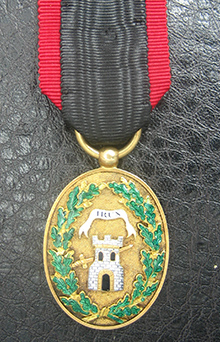
SPANISH IRUN 1837 MEDAL, OFFICERS, IN GOLD AND ENAMEL ‘IRUN LIEUT. GENL. EVANS SP’ NA’ ARMY 17 MAY 1837;
General Sir George de Lacy Evans, G.C.B., was born in 1787, in Moig, County Limerick, Ireland. He was educated at Woolwich Academy and joined the East India Company's forces in 1800, before volunteering for the British Army in India in 1806. De Lacy Evans was commissioned Ensign in 22nd Foot the following year, before exchanging into the 3rd Light Dragoons for service in the Peninsular War. He served with distinction in America, and was at Bladensburg, the burning of Washington and the Battle of North Point.
De Lacy Evans was actively involved in the New Orleans campaign at the conclusion of the War of 1812. He was the only British Army officer present at the Royal Navy 'small boat action' on Lake Borgne (entitled to N.G.S. with 14 December Boat Service 1814 clasp) and was wounded at the battle of New Orleans. de Lacy Evans was present at the battle of Quatre Bras on 16 June 1815 and the battle of Waterloo on 18 June 1815 (entitled to M.G.S. with Vittoria, Pyrenees and Toulouse clasps and Waterloo Medal).
De Lacy Evans commanded the British Legion, which volunteered to assist Isabella II of Spain in the First Carlist War, and commanded the 2nd Division of the British Army during the Crimean War (France, Grand Cross Legion of Honour). He advanced to General in March 1861, and served as a Member of Parliament for Rye in 1830-1832, and for Westminster from 1833-1841 and 1846-1865. He died in January 1870.
Several versions of the Irun medal appear to have been awarded, a simple type for other ranks and a couple of enamelled versions to Officers with and without flags. See the following example:
https://www.spink.com/lot/24001000396
However this version belonging to de Lacy Evans appears to be of even finer quality, clearly named to reverse and lacks the flag. Critically several portraits of de Lacy Evans appear to show him wearing a version of the Irun medal without the flags:
https://www.npg.org.uk/collections/search/portraitExtended/mw02147/Sir-George-de-Lacy-Evans.
De Lacy Evans awards are held in the Queen’s Own Royal Hussars Museum, Warwick. However they have confirmed they are not in possession of a Irun medal awarded to him.
In May 1837, while the bulk of the Carlist Army was absent on the Royal Expedition, the troops of the Liberal garrison of San Sebastian led by General Sir George de Lacy Evans, Commander of the British Auxiliary Legion, launched an offensive to take the joining the city with the French border. They had just received reinforcements from troops in Portugalete and close to 20,000 men left San Sebastian to take Lezo, Rentería, Astigarraga and Hernani on the 14-15 May 1837.
Espartero set up base in Hernani, in order to protect Evans' troops, which were heading to Oiartzun and the mouth of the river Bidasoa. The Carlists abandoned Oiartzun when they saw Jáuregui's division advancing, but decided to stand firm in Irun.
This garrison was defended at the fort of "El Parque" and the Town Hall, which had been fortified for the occasion. Just 500 Carlists, made up of troops and volunteers, faced Evans' 12,000 men, 5,000 of whom were British and recently humiliated in the Battle of Oriamendi. On the afternoon of the 16th, the British artillery began bombarding, but only managed to take the houses outside the city walls. The offensive began again at daybreak on the 17 May and lasted all day because of the strong Carlist defence.
The Liberal cannons were not powerful enough, so they were forced to attack with the infantry and take the city almost house by house, suffering many casualties in the act. The Town Hall and fort finally surrendered that same afternoon. The long, drawn-out battle and numerous casualties gave rise to the sacking of the town, mainly by the British troops. Hondarribia surrendered the day after without resistance. The Guipuzcoan border was now controlled by the Liberals.
https://www.qrhmuseum.com/general-sir-george-de-lacy-evans-gcb
Condition NEF, minor loss of enamel to a couple of leaf tips or better. Ex Baldwin and Dixon Medals 2023. An extremely rare and possibly unique medal to an important British General.